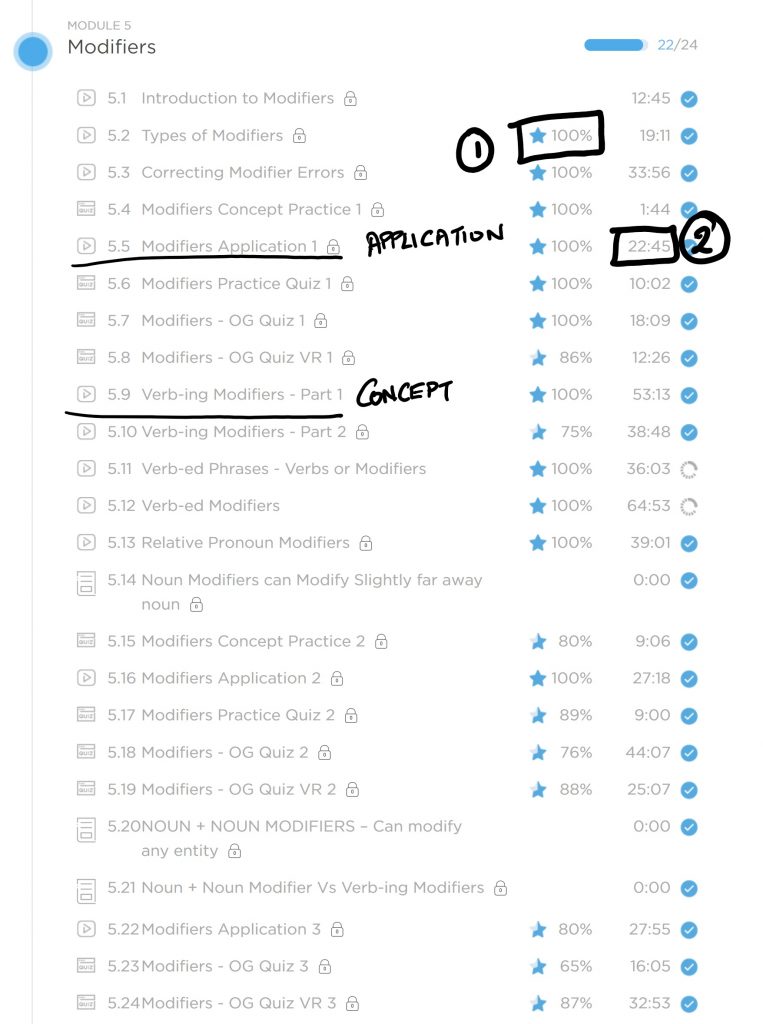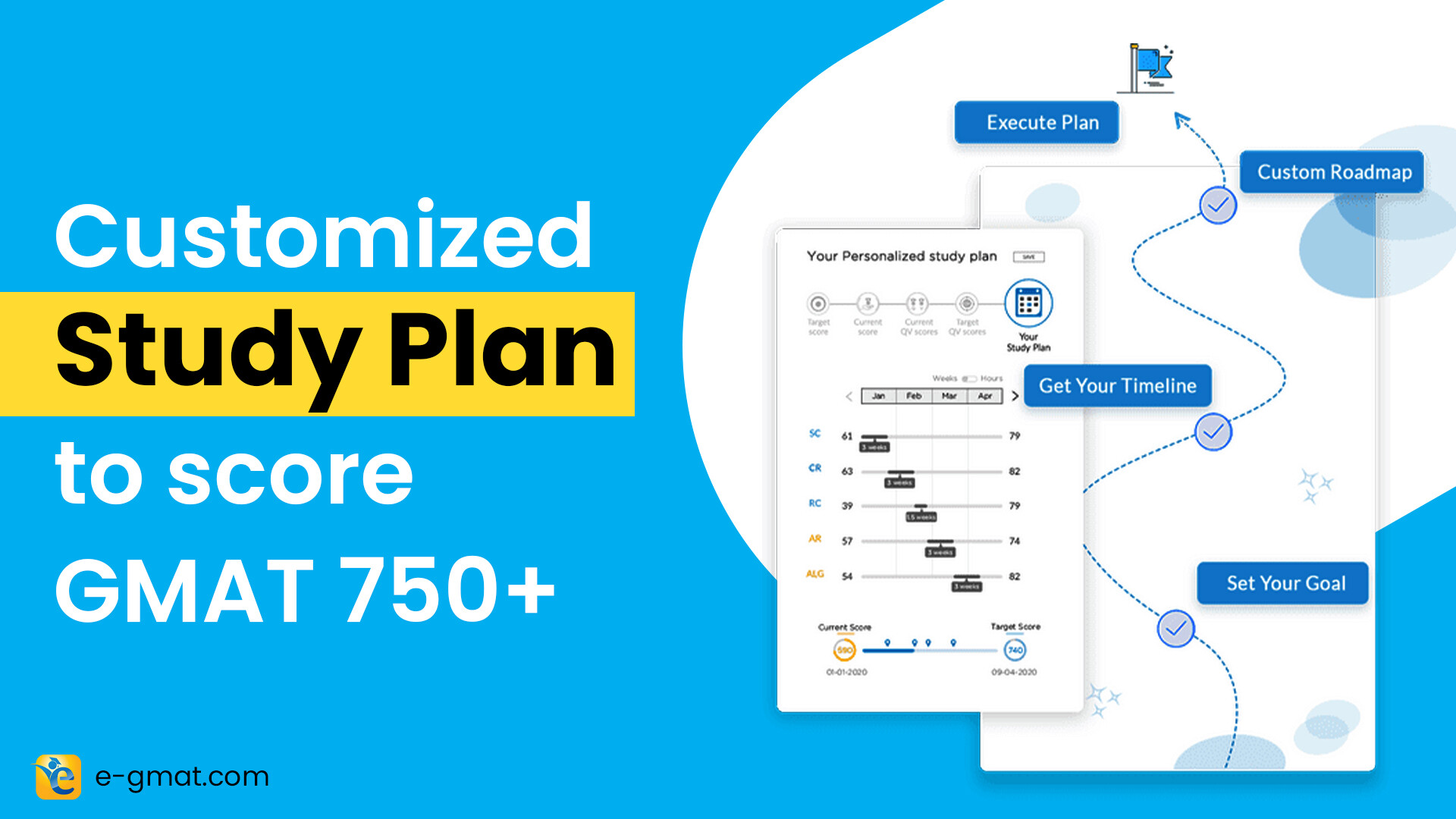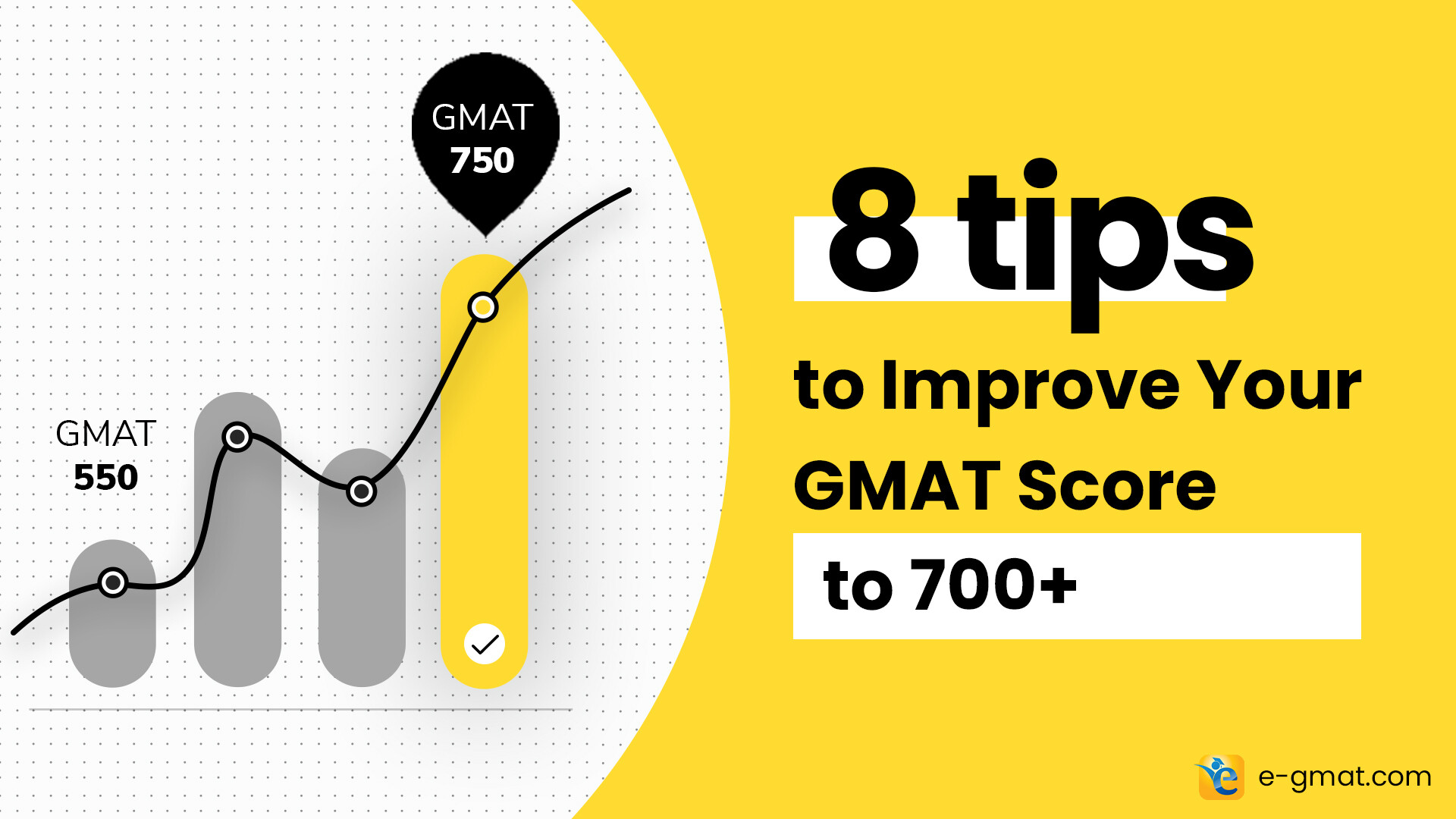Read the statements below. And if you agree with at least 1 statement, then spend the next 10 minutes reading this article. If you do not agree with any of the statements, then also read this article till this section so that you solidify your belief further. Positive reinforcement of one’s beliefs is always welcome!
- To ace the GMAT, I need to practice as many questions as I can. After all, practice makes the man (or the woman) perfect.
- To ace the GMAT, I need to find the quickest ways to solve questions. After all, it is a timed test. So, it is important to look for shortcuts so that I can shave off time to solve questions.
- To ace the GMAT, I need to be able to solve a certain specific number of questions correctly.
- Once I prepare, one of the most effective ways (or maybe even “the only way”) to determine my improved level is through mock tests.
Before I go further, let me make this statement –
“I do not agree with any of the statements above”.
After analyzing the attempts of 600 students (300 successful, and 300 unsuccessful), we concluded, the following.
- Students who are successful (i.e. score 730+) solve spend just as much time preparing for the GMAT as students who fail (i.e. score 650 or lower). Note, in most cases, their starting points are also similar.
- In general, students who fail, solve more questions than those who are successful.

In this article, we will look to answer the following questions:
- What do successful students do differently from unsuccessful ones?
- Where do unsuccessful students falter?
- How data and insights, when used properly, drive success or predict failure?
So, let’s proceed. Here are the chapters in this article.
- Chapter 1 – What does the GMAT test?
- Chapter 2 – What are the three stages of learning to ace the GMAT?
- Chapter 3 – What does data tell us about the strategies used by successful GMAT test-takers through stages 1 and 2 of their preparation?
- Chapter 4 – What does data tell us about the strategies used by GMAT test takers who failed?
- Chapter 5 – What are the three takeaways from this article?
What does the GMAT test?
Since all the questions above pertain to how to ace the GMAT, it is important to first set the context of what GMAT tests you on. GMAT is the test of your ability. And for the benefit of the test takers, ‘ability’ in the context of the GMAT is a quantifiable measure that is reported in the ESR.
To demonstrate the same, let’s take two ESRs. For the sake of simplicity, we will focus only on SC ability information provided in these ESRs.

- 730-scorer got 94th percentile in SC
- 640-scorer got only 46th percentile in SC.
Now, what does this percentile mean? Essentially, GMAT rates students based on two aspects –
- knowledge of concepts
- ability to apply the concepts
Translating the ability information in plain English by utilizing this rating definition used by the GMAT, we get the following:
The GMAT ranks test takers in terms of their knowledge and application of concepts in the five sub-sections. Higher the rank in the sub-sections, higher the overall GMAT score.
- In terms of his knowledge of SC concepts and his ability to apply these SC concepts, the 730-scorer is better than 94 percent of test-takers.
- Likewise, in terms of her knowledge of SC concepts and her ability to apply these SC concepts, the 640-scorer is better than only 46 percent of test-takers.
So, GMAT ranks test-takers in terms of their knowledge and application of concepts in the five sub-sections. Higher the rank in the sub-sections, the higher the overall GMAT score.
Thus, in order to score higher 730+ on the GMAT, one needs to build not only one’s knowledge of concepts but also the skill set of applying these concepts to solve questions.
In the next chapter, I will explain to you the three stages of learning to ace the GMAT.
What are the three stages of learning to ace the GMAT?
If you want to score better than 94% of test-takers, i.e. 730+ score, then you need to prepare for the test in a methodical manner that builds your ability to solve difficult questions – the basis of your GMAT score. For this purpose, (starting at the appropriate stage) a student MUST go through these 3 stages of learning and excelling for each sub-section.
- Stage 1 – Learn concepts and methods
- Stage 2 – Cement methods
- Stage 3 – Do test readiness
Now as you move from stage 1 to stage 2, your ability improves. Typically, after stage 1, i.e. after learning the concepts and methods “properly”, one’s ability improves to about 60 percentile level (50-70 percentile), in some cases even to 70 percentile level. And this provides a very solid launchpad for stage 2 in which now the student is able to push his ability to 90 percentile level. If you want more details on how this happens, watch this video
Recap
So far you have learned the following:
- GMAT tests ability
- ability is a quantifiable measure
- ability improves as one goes from stage 1 to stage 2
And an obvious question that you should have in your mind is – if the ability is a quantifiable measure, and GMAT tests ability, then how do I measure my ability as I move from stage 1 to stage 2 to stage 3? What are the tools available that make this possible?
In the next chapter, I will answer this question by showcasing the breadth and depth of information that successful students utilize through stages 1 and 2 of their GMAT preparation journey.
What does data tell us about the strategies used by successful GMAT test-takers?
For the sake of simplicity, we will discuss stages 1 and 2 of the sentence correction sub-section. Now you understand that to achieve that 90-percentile ability in SC, the student needs to accomplish two things:
- Gain proficiency in at least 200 SC concepts
- Build skill set in applying these concepts to solve SC questions using ONE method.
A student gets personalized feedback 87 times in e-GMAT SC course. Most feedback points take at least 5 evaluation items into consideration.
As the student progresses through stage 1 utilizing the e-GMAT SC course, he gets feedback on an average every 30 minutes. To be precise, he gets 87 data points of feedback, most feedback points based on at least 5 evaluation items. This feedback tells him one of two things:
- Has he learned the set concepts to the required degree?
- Has he learned the application of these concepts to the required degree?
1.1 Stage 1 Data
With this background, let us look at the data that these 5 successful students obtained through these 87 feedback points. Note, this data representative of the 300 successful cases.
| GMAT Club Profile name | Score (GMAT-Verbal) | Concept Score | Application Score | Number of Positive feedback points | Number of Corrective actions needed |
| Dr Rohit Malan | 760 – V41 | 93% | 90% | 77 | 10 |
| pg11 | 740 – V40 | 93% | 78% | 70 | 17 |
| moderator | 720 – V42 | 93% | 88% | 79 | 8 |
| sireeshs | 750 – V42 | 92% | 80% | 72 | 15 |
| pnishant | 740 – V41 | 92% | 91% | 80 | 7 |
Before I explain each data column in detail, let’s do a quick explanation of what each column stands for:
- GMAT Club Profile Name – Each of these students is associated with GMAT Club in some form or another. They have either shared their GMAT experience or are GMAT club moderators. Given the camaraderie of this community, I do not believe they will mind if you reach out to them about their experience.
- Score (GMAT – Verbal) – This column shows the score obtained by each of these students.
- Concept Score – This column shows the average score that the student obtained in all the quizzes that test conceptual understanding of the student. So, this metric is a strong indicator of the conceptual understanding of the student.
- Application Score – This column shows the average score that the student obtained in all the quizzes that test the skill set of the student in applying the method to solve SC questions. So, this metric is strong indicator of the application acumen of the student.
- Number of Positive Feedback Points – As I said earlier, in Stage 1 of SC, the student gets 87 feedback points. These feedback points either provide positive reinforcement or provide corrective actions. Thus, this column indicates, out of 87, the number of feedback points that provided positive reinforcement to the student.
- Number of Corrective Action needed Feedback Points –This column indicates, out of 87, the number of feedback points that indicated to the student that he needs to apply the corrective actions.
One additional point: Most of the 300 successful students completed the SC course in 15 days or fewer. In fact, their median time to complete the course was 12 days, indicating that they maintained consistency, doing the course without taking a long break in between.
Concept Scores
An average score greater than or equal to 90% is a strong indicator of the student’s acceptable level of proficiency in conceptual knowledge. As is evident from the table, successful students gain high proficiency in their conceptual understanding. This is very important since it is one of the key aspects based on which GMAT determines the ability.
Food for thought
“How would you find out if you have some conceptual gaps in relative pronouns or verb-ing modifiers or noun + noun modifiers or basic understanding of modifiers?
Without solving full-length SC questions, how many times were you able to identify that you have some conceptual gaps pertaining to relative pronouns or verb-ing modifiers or noun + noun modifiers?”

Application Scores
An average score greater than or equal to 80% is a strong indicator that the student is skilled in applying the meaning-based method to solve SC questions. As is evident from the scores in this table, successful students work towards learning the process in this stage. They don’t learn all the concepts first and then practice full-length problems at the end of learning all 200 concepts. They learn the application of the method alongside building proficiency in concepts.
Food for thought:
How many modifier-based SC questions did you solve after you learned about the basics of modifiers? Likewise, how many modifier-based SC questions did you solve after you learned about verb-ing modifiers and relative pronoun modifiers? And then how many modifier-based SC questions did you solve after you learned about the noun+ noun modifiers?
Number of Positive Feedback Points
Building proficiency in over 200 concepts in a methodical manner and learning the method to solve SC questions require effort and diligence.
Successful students understand the utility of each component of the e-GMAT course and hence they do them right the first time. They know the purpose of concept files; they know what they must focus on while doing the application files; they know that they should review the solutions in detail so that they build their skill set in applying the methods. Accordingly, they get more positive feedback points. As is evident in the table above, over 80% of feedback points received by successful students are positive i.e. they did these components right the first time.
In addition, successful students utilize these positive feedback points to give them the positive reinforcement that keeps them focused on the task at hand – successfully completing Stage 1 to reach at least 60th percentile ability.
Food for thought:
When you solve a question incorrectly, do you know if you answered it incorrectly because of conceptual gap or method gap? How many times have you received motivation from your course material? How many times have you felt that confidence that you are preparing in the right manner and that you are headed along the right path?
Number of Corrective Action needed Feedback Points
Successful students also realize that they can falter at many places. And they know what to watch out for and what to do to correct the same. They take the feedback points that tell them to take corrective actions very seriously. They spend the time on the content again – ensuring that they learn from the mistakes.
Example 1

Verb sequencing (3.3) file contains 5 questions in which we teach how to sequence verbs. The student did not do as well on this file. Notice the amount of time – more than an hour – that he spent reviewing this file so that he bridges his conceptual gaps. As a result, his score in the practice test right after it was perfect.
FOOD FOR THOUGHT:
What aspect of your test prep course/material prompts you to spend more effort on the content?
1.1 Stage 2 Data
Context
A student who does stage 1 well enters stage 2 with ~60th percentile ability. In stage 2, through focused feedback the student then improves from that ~60th percentile to more than 80th percentile.
Data of successful students
Now we will look at the data that these five successful students received in Stage 2 of their preparation for SC. Note that Stage 2 for any sub-section is done using e-GMAT’s analytics platform – Scholaranium.
| GMAT Club Profile name | GMAT Score | Accuracy – Easy Qs | Accuracy – Medium Qs | Accuracy – Hard Qs | Total # of questions |
| rsmalan | 760 | 95% | 80% | 76% | 78 |
| pg11 | 740 | 80% | 84% | 68% | 135 |
| moderator | 720 | 82% | 75% | 69% | 457 |
| sireeshs | 750 | 82% | 78% | 64% | 168 |
| pnishant | 740 | 93% | 96% | 70% | 244 |
Let’s go over the columns for this table as well.
- The first two columns are the same as for Stage 1 data – profile and GMAT score information of the five successful students.
- Columns 3, 4, and 5 present data for three difficulty levels of questions – easy, medium, and hard
- Column 6 lists the total number of questions attempted by the student.
Observation 1 – accuracies in easy, medium, and hard questions
Observe the high accuracies – > 80% – in both easy and medium questions. Not only that, the accuracy in hard questions is also ~ 70% in most cases.
Successful students systematically build their ability. They do each step correctly so that they set themselves up for success in the next step in the learning architecture.
In most cases, successful students first prove their skill set in medium questions – they target >70% accuracy for medium difficulty level questions. They do a strategic review of each question so that they learn from each mistake. This thorough review increases their accuracy in medium difficulty level questions to more than 80%. And only after they achieve this improved skill level in medium questions, they start solving hard questions.
So, the thing to notice is that successful students systematically build their ability. They do each step correctly so that they set themselves up for success in the next step in the learning architecture.
Food for thought
As you prepare for your GMAT, do you know when you should start solving medium difficulty level questions? Likewise, do you know when you should start solving hard questions?
Observation 2 – number of questions solved
Before I draw your attention to the data here, I want to make one statement. Most e-GMATers have access to ~450 questions in SC in Scholaranium (in addition to ~200+ questions in the course).
Now, observe the number of questions solved by rsmalan (78) and pg11 (135) – the two successful students who (practically) used e-GMAT for one attempt only and reached their target scores of >V40. They did not use up even half of the questions available to them.
Next, observe the number of questions solved by successful students who used e-GMAT twice to improve their score to >V40. Even in two attempts, they did not exhaust all the questions available to them. Yes, only one of them used up all the questions. While we are talking about just 5 students here, this is a trend that we see prevalent across most of the 300 successful students we analyzed. Essentially, after doing stage 1 successfully, students don’t need to solve 100s of questions hit 90th percentile ability in stage 2.
Successful students do just that – they look at the data that Scholaranium provides …and they take actions accordingly.
You may be wondering – why does it matter how many questions successful students solve. It matters because you all are working on balancing your time between the multiple commitments that you have. So, ideally, why should you be blindly solving question after question if you have achieved your target sub-sectional ability.
Successful students do just that – they look at the data that Scholaranium provides ..and they take actions accordingly.
Food for thought
As you prepare for your GMAT, do you know when you should start solving medium difficulty level questions? Likewise, do you know when you should stop solving hard questions?
This food for thought takes you back to the question that I asked you upfront. I asked you if you believe in one of these statements.
“To ace the GMAT, I need to practice as many questions as I can. After all, practice makes the man (or the woman) perfect.”
As a learning from this section, I urge you to stop believing in this statement above:
- Because to ace the GMAT, you DO NOT need to practice as many questions as you can, rather you need to focus on achieving perfection.
- Instead, you need to utilize data to guide you on the kind of questions you need to attempt, which questions you need to strategically review, and when do you need to stop solving questions.
Learnings from preparation data of successful students
So, based on our review of the data of successful students, you can see how students who are successful follow these strategies:
- Successful students do Stage 1 diligently, incorporating all feedback provided by hundreds of data points provided in the course.
- Since successful students do Stage 1 properly, they start stage 2 on a solid launchpad and are able to reach their target percentiles with a focused effort by utilizing the feedback given by Scholaranium.
- Successful students efficiently prepare for the test by investing just the right amount of effort since they utilize the data to guide them.
To summarize, successful students are successful because they know how to use data to guide their preparation, put in effort diligently where needed, and revise their mistakes strategically.
What does data tell us about the strategies used by GMAT test takers who failed?
In this chapter, we will review information from five students, each of whom failed in their GMAT attempt.
| GMAT Club Profile | Score (GMAT-Verbal) | Concept Score (Avg) | Application Score (avg) |
| 1nvh | 510 – V22 | 70 | 69 |
| 2anan | 530 – V20 | 81 | 63 |
| 3zal | 590 – V23 | 88 | 89 |
| 4tar | 550 – V24 | 78 | 61 |
| 5ndv | 620 – V33 | 79 | 72 |
Let’s first understand the column headers before we go into drawing inferences from this data and our understanding of the manner in which successful students approach their GMAT preparation using the three stages of learning and excelling.
- Student alias – in order to conceal the identity of these students, we have used aliases.
- The second column presents the low GMAT score that the students obtained. In addition, their verbal scores are also presented.
- The next set of columns includes scores in concept and application files.
Now let’s start making observations about this data.
Inference 1 – Most students who fail, fail because they do not do stage 1 properly
Recollect what we learned from the data for successful students – if a student does stage 1 properly, then his average concept scores are greater than 90% and his average application scores are greater than 80%.
Now observe the average concept and application scores for the students in this table. Except for one student in this list – 3zal – everyone has average concept score less than 80% and average application score less than 70%.
| GMAT Club Profile name | Score (GMAT-Verbal) | Concept Score (Avg) | Application Score (avg) | # of Positive feedback points | # of Corrective actions needed |
| 1nvh | 510 | 70 | 69 | 45 | 42 |
| 2anan | 530 | 81 | 63 | 51 | 36 |
| 3zal | 590 | 88 | 89 | 61 | 26 |
| 4tar | 550 | 78 | 61 | 44 | 43 |
| 5ndv | 620 | 79 | 72 | 62 | 25 |
This is a solid indicator of failure. And these students failed to observe this solid indicator. These students did not pay heed to more than 50% feedback points that prompted them to take corrective actions; i.e. they don’t spend enough time revising their mistakes. Instead, they are happy to move on to the next learning activity.
Students who fail do not utilize the feedback provided to them, and instead of taking corrective action, move on to the next activity.
In addition, many students falling in this category also tend to digress. Many of them, anxious to gauge their progress after having only spent a few hours on the platform, feel the urge to take a mock test or practice questions on an alternate platform. While 70% of these students completed the SC course, a majority of them took more than 12 days to complete the course, mostly because they took a few days of break, taking mock(s) or practicing elsewhere.
This phenomenon is what I call as missed opportunity that potentially costs these students upwards of $500K over the course of 10 years.
Inference 2 – Most Students who do not do Stage 1 properly are unable to do stage 2 properly.
| Student alias | GMAT Score | Easy – accuracy | Medium – Accuracy | #Hard – Accuracy |
| 1nvh |
510 | 75% | 67% |
36% |
| 2anan |
530 | 74% | 57% |
39% |
| 3zal |
590 | 60% | 45% |
27% |
| 4tar |
550 | 25% | 33% |
20% |
| 5ndv |
620 | 81% | 68% |
40% |
We know that if a student does stage 1 properly, then he starts off from a very solid launch pad to improve his ability to solve hard questions. That is why such students are able to answer at least 70% of medium difficulty level questions correct right after finishing stage 1. And as they cement their methods utilizing Scholaranium, they are able to take their accuracy of even hard questions up to > 70%.
Now contrast this information with the data of students who failed. Many of these students are not even able to solve medium difficulty questions with 70% accuracy (many are below 60%). So, solving hard questions with 70% accuracy is completely out of question. As you can see from the table, none of them solved even 40% of hard questions correctly
Inference 3 – Many Students who fail, solve a large number of questions with no direction (or GIVE up).
As is evident from the table, students who fail do not solve questions with the right intent. Their goal is just to solve question after question without paying attention to doing a proper strategic review of the solution. Students 2anan, 3zal, and 5ndv solved way more than 150 questions and that too with no direction whatsoever.
Inference 4 – Students who fail also ignore warning signs as strong as those provided by SIGma-X mocks
| Student alias | Actual GMAT Score | SIGma-X mock score |
| 1nvh |
510 |
n/a |
| 2anan |
530 |
n/a |
| 3zal |
590 |
580 – V23 |
| 4tar |
550 |
n/a |
| 5ndv |
620 |
620 – V33 |
First, observe the entries for 3zal and 5ndv. These students took SIGma-X mock test 3-4 days before they took their GMAT. And notice that they scored the exact same score in SIGma-X mock test that they scored in their GMAT attempt. And per the emails that they sent us, they told us that they had been scoring 700-720 in the other mock tests that they took.
Even though many of these students scored low on SIGma-X mock, many ignored these signs instead relying on the scores provided by other less reliable mocks
Such is the power of SIGma-X mock tests. Through analysis of at least 500 attempts, we have noticed a very strong correlation between SIGma-X mock tests and the actual GMAT score. But students who fail, ignore this obvious warning sign since they get rosy data from mocks that are truly not representative of the GMAT exam. This is rather a human characteristic – we believe what we want to believe in – and at that time we do fail to take into consideration the authenticity of the data source.
Summary
GMAT is a test of ability and those who build high ability in various sub-sections score high. To build ability, most students need to excel in three stages of learning. These stages are – Learn concepts and methods, cement methods, and achieve test readiness. In stage 1 – learning concepts and application (in SC), successful students leverage as many as 80+ feedback points to ensure that they learn properly. Unsuccessful students, anxious to take mocks and solve questions, ignore the same feedback points.
Students who improve to 730+ leverage data to excel in the three stages of learning while those who fail either ignore the same data points
Equipped with the right foundation and having learned the methods, successful students typically need to practice 150 or fewer questions in stage 2 to reach their target sub-sectional ability. A strategic review of every mistake is an integral part of their strategy. Hence, with each question they solve, they grow more confident.
On the other hand, unsuccessful students, who are just as capable, end up solving hundreds of questions in stage 2, often exhausting the pool of questions they have. Reviewing mistakes strategically is not integral to their process of solving questions. Hence, they grow more frustrated and anxious as they solve more questions, some even resorting to getting in “GMAT is a scam” mode. Many of them give up their MBA dreams or settle for scores of 650 or lower.
Overall, students who score lower than 650 are just as capable and spend just as many hours preparing for the GMAT as those who score 730+. The difference between those who score 730 and those who score 650 is how they use data to excel. Students who improve to 730+ leverage data to excel in the three stages of learning while those who fail either ignore the same data points or don’t track the data. Unsuccessful students start leveraging data, have the potential to get much higher scores.
If you are planning to take the GMAT, we can help you with a personalized study plan and give you access to quality online content to prepare. Write to us at acethegmat@e-gmat.com. We are the most reviewed GMAT prep company on gmatclub with more than 2400 reviews and are the only prep company that has delivered more than 700+ scores than any other GMAT club partner. Why don’t you take a free trial and judge for yourself?














